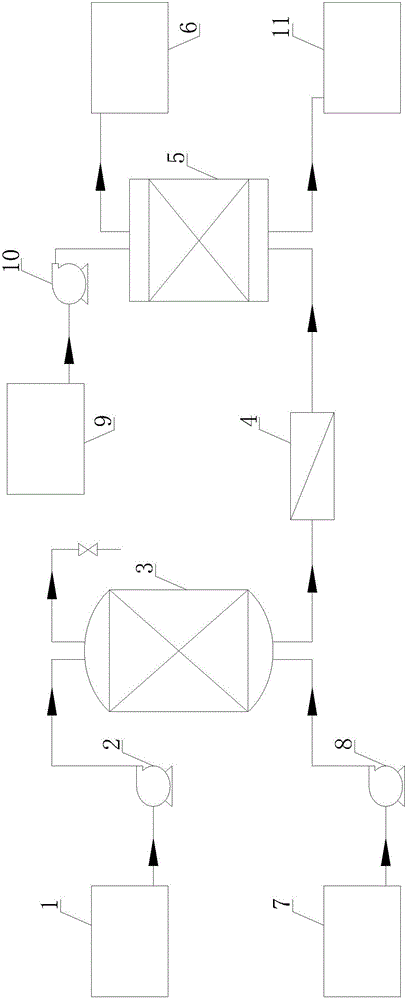Waste acid resourceful treatment process based on nano-composite carrier retarding method
A nano-composite and treatment process technology, applied in the direction of metallurgical wastewater treatment, filtration treatment, special treatment targets, etc., can solve the problems of low acid recovery rate, high operating cost, low recovery concentration, etc., and achieve high separation rate and low operating cost. Effect
- Summary
- Abstract
- Description
- Claims
- Application Information
AI Technical Summary
Problems solved by technology
Method used
Image
Examples
Embodiment 1
[0042] (1) Suspension copolymerization
[0043] In a 3000L polymerization reactor, add 1,275kg of 4% NaCl solution by mass, add 2.5kg of polyvinyl alcohol with a polymerization degree of 1000 and an alcoholysis degree of preferably 80%, and heat to 55°C to make the polyvinyl alcohol fully Disperse in the solution; add 235kg of divinylbenzene, 265kg of styrene, 125kg of liquid wax, 125kg of toluene, 100kg of xylene, 2.5kg of benzoyl peroxide, and keep the temperature at 45~55℃. At the same time, the mixer is stirred at a constant speed of 800r / min for 1h.
[0044] After 1h, raise the temperature to 77℃ and keep it for 4h; then, raise the temperature to 87℃ and keep it for 3h; then raise the temperature to 97℃, keep it for 5h, and then release the NaCl solution in the reactor to prepare Copolymer sphere I.
[0045] (2) Washing and drying
[0046] The copolymer sphere I obtained in step 1 was transferred to a 3000L distillation kettle, and 1000kg of acetone and petroleum ether mixed li...
Embodiment 2
[0055] (1) Suspension copolymerization
[0056] In a 7000L polymerization reactor, add 5250kg of NaCl solution with a mass concentration of 6%, add 14kg of polyvinyl alcohol with a polymerization degree of 2000 and an alcoholysis degree of preferably 85%, and heat to 55°C to fully disperse the polyvinyl alcohol in Add 335kg of divinylbenzene, 365kg of styrene, 445kg of liquid wax, 345kg of toluene, 260kg of xylene and 7.7kg of benzoyl peroxide with a mass percentage of 60% in the solution; mix well and keep the temperature at 45~55℃. , The mixer is stirred at a constant speed of 1000r / min for 1h.
[0057] After 1h, raise the temperature to 77℃ and keep it for 4.5h; then raise the temperature to 87℃ and keep it for 3.5h; then raise the temperature to 97℃ and keep it for 6.5h, and then release the NaCl solution in the reactor , The copolymer sphere I was prepared.
[0058] (2) Washing and drying
[0059] The copolymer sphere I obtained in step 1 was transferred to a 3000L distillation...
Embodiment 3
[0068] (1) Suspension copolymerization
[0069] In a 5000L polymerization reactor, add 4400kg of NaCl solution with a mass concentration of 5%, add 10kg of polyvinyl alcohol with a degree of polymerization of 1500 and an alcoholysis degree of preferably 83%, and heat to 55°C to fully disperse the polyvinyl alcohol in In the solution; add 70% by mass of divinylbenzene 400kg, styrene 600kg, liquid wax 450kg, toluene 400kg, xylene 350kg, benzoyl peroxide 10kg, mix well, keep the temperature at 45~55℃, at the same time, The mixer is stirred at a constant speed of 900r / min for 1.5h.
[0070] After 1.5h, raise the temperature to 77℃ and keep it for 5h; then, raise the temperature to 88℃ and keep it for 4h; then raise the temperature to 97℃ and keep it for 7h, then release the NaCl solution in the reactor to prepare The copolymer sphere I was obtained.
[0071] (2) Washing and drying
[0072] The copolymer sphere I obtained in step 1 was transferred to a 3000L distillation kettle, and 1200...
PUM
| Property | Measurement | Unit |
|---|---|---|
| particle diameter | aaaaa | aaaaa |
| particle size | aaaaa | aaaaa |
| particle diameter | aaaaa | aaaaa |
Abstract
Description
Claims
Application Information
 Login to View More
Login to View More - R&D
- Intellectual Property
- Life Sciences
- Materials
- Tech Scout
- Unparalleled Data Quality
- Higher Quality Content
- 60% Fewer Hallucinations
Browse by: Latest US Patents, China's latest patents, Technical Efficacy Thesaurus, Application Domain, Technology Topic, Popular Technical Reports.
© 2025 PatSnap. All rights reserved.Legal|Privacy policy|Modern Slavery Act Transparency Statement|Sitemap|About US| Contact US: help@patsnap.com

